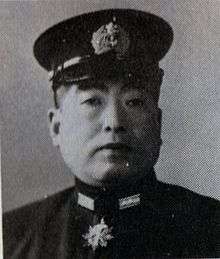Masami Kobayashi
| Masami Kobayashi | |
|---|---|
 Admiral Masami Kobayashi | |
| Born |
18 June 1890 Yonezawa, Yamagata, Japan |
| Died | 7 August 1977 (aged 87)[1] |
| Allegiance |
|
| Service/branch |
|
| Years of service | 1910–1944 |
| Rank | Vice Admiral |
| Battles/wars |
Second Sino-Japanese War Pacific War |
Masami Kobayashi (小林仁 Kobayashi Masami or Kobayashi Masashi, 18 June 1890 – 7 August 1977) was an admiral in the Imperial Japanese Navy during World War II. His name was sometimes misspelled as “Marasmi Kobayashi” or “Marashi Kobayashi” by contemporary United States Navy sources. He was an outspoken proponent of the Treaty Faction within the Imperial Japanese Navy.
Biography
Kobayashi was a native of Yonezawa, Yamagata, where his father was a farmer. With the assistance of a clique of admirals within the Imperial Japanese Navy from former Yonezawa Domain (including Yamashita Gentarō and Chūichi Nagumo), he entered military preparatory schools and graduated 4th out of 149 cadets from the 38th class of the Imperial Japanese Navy Academy. His classmates included Michitaro Totsuka, Takeo Kurita, Rokuzō Sugiyama, Gunichi Mikawa and Aritomo Gotō. After serving on the cruiser Kasuga and battleship Asahi, Kobayashi was sent to the United Kingdom as part of the crew bringing the new battlecruiser Kongō to Japan. After attending the naval artillery and torpedo warfare schools, he served on the destroyer Kisaragi before attending the Naval Staff College in 1916, where he specialized in navigation.
On graduation and promotion to lieutenant, Kobayashi served as chief navigator on the survey vessel Katsuriki and the aging cruiser Akitsushima. He then returned to shore duty from 1919-1921 with the IJN 3rd Fleet and served as an instructor at the Navy Academy. He returned again to the Naval War College in 1921, and was promoted to lieutenant commander on graduation in 1922. His first command was from 1923-1925 of the river gunboat Japanese gunboat Hira, which operated on the Yangtze River in Shanghai. From December 1925 to April 1928, Kobayashi served as a naval attaché to the United States. He was promoted to commander on 1 December 1927. After his return to Japan, Kobayashi served as executive officer on the submarine tender Chōgei. He was promoted to captain on December 1, 1931. A week later, he was sent to Geneva as an attendant to the Geneva Conference. In November 1932, he returned to the United States as a naval attaché, remaining until June 1934.
In December 1936, Kobayashi was appointed captain of the battleship Yamashiro. With the start of the Second Sino-Japanese War, Kobayashi became Chief of Staff of the IJN 4th Fleet and was based at Tsingtao as assistant to Rear Admiral Soemu Toyoda. On 1 December 1937, Kobayashi was promoted to rear admiral. From September 1938 to November 1939, he served as Chief of Staff of the Sasebo Naval District. He returned to the China front in November 1939 as Commander of the Naval Base Forces in Wuhan, and from November 1940 in Shanghai. He returned to Japan in May 1941. On 15 October 1941, Kobayashi was promoted to vice admiral.
World War II
Shortly before the attack on Pearl Harbor, Kobayashi was commander of the Osaka Guard District. He remained in that position until March 1943 and despite having more combat experience than many of his colleagues, was assigned to personnel recruitment, munitions production and general bureaucratic duties. It was not until after the tide of the war started to change that Kobayashi was permitted to return to combat status with his appointment to command the IJN 4th Fleet on 1 April 1943. The IJN 4th Fleet was responsible for the defense of the South Pacific, although its responsibilities overlapped, and often conflicted with the IJN 2nd Fleet, IJN 6th Fleet and the Combined Fleet.
In November 1943, the Allies were victorious at the Battle of Tarawa and Battle of Makin in the Gilbert Islands, and in early February 1944 seized critically strategic positions in the Marshall Islands with the Battle of Kwajalein and the capture of Roi-Namur. Realizing that the major Japanese naval base in the South Pacific at Truk was endangered, Kobayashi ordered the naval assets there transferred to Palau. However, before the transfer could be complete, the United States launched Operation Hailstone, sinking a large number of Japanese warships and transports. The Imperial Japanese Navy General Staff blamed Kobayashi for the defeat, and relieved him of his command two days later. On 30 May 1944, Kobayashi was forced from active service and on 31 May 1944 he went into the reserves.
After the surrender of Japan, Kobayashi was detained a Sugamo Prison in Tokyo by the SCAP authorities, and charged with command responsibility for the war crimes perpetrated by Admiral Shigematsu Sakaibara in the "Wake Island Massacre". His case never came to trial, and he was released from Sugamo Prison in 1952.
In the post-war period, Kobayashi served as an advisor and instructor for the Japan Maritime Self-Defense Force.
Notes
- ↑ Nishida, Hiroshi. "Imperial Japanese Navy".
References
- Nishida, Hiroshi (2002). "Imperial Japanese Navy".
Further reading
- D'Albas, Andrieu (1965). Death of a Navy: Japanese Naval Action in World War II. Devin-Adair Pub. ISBN 0-8159-5302-X.
- Dull, Paul S. (1978). A Battle History of the Imperial Japanese Navy, 1941-1945. Naval Institute Press. ISBN 0-87021-097-1.
- Dupuy, Trevor N. (1992). Encyclopedia of Military Biography. I B Tauris & Co Ltd. ISBN 1-85043-569-3.
- Parrish, Thomas (1978). The Simon and Schuster Encyclopedia of World War II. New York: Simon and Schuster. ISBN 0-671-24277-6.
- Van Der Vat, Dan (1978). Pacific Campaign: The U.S.-Japanese Naval War 1941-1945. New York: Simon and Schuster. ISBN 0-671-79217-2.
- The Marshall Islands by Gordon L. Rottman (2004) ISBN 1-84176-936-3